Characteristics and Paleoenvironment of Stromatolites in the Southern North China Craton and Their Implications for Mesoproterozoic Gas Exploration
Abstract
1. Introduction
2. Geological Background and Sample Collection
Geological Overview
3. Sampling and Analytical Methods
3.1. Sample Collection
3.2. Sample Testing and Analysis
3.2.1. Carbon and Oxygen Isotope Analysis
3.2.2. Major and Trace Element Analysis
3.2.3. Total Organic Carbon Analysis
3.2.4. Electron Probe Microanalysis
3.2.5. Cathodoluminescence
4. Results and Interpretation
4.1. Characteristics of Stromatolites
4.1.1. Macroscopic Features
4.1.2. Microscopic Characteristics
4.2. Electron Probe Microanalysis (EPMA)
4.3. Comparison of Light and Dark Bands in Stromatolitic and Laminated Structures
4.3.1. Stromatolitic Structure
4.3.2. Laminated Structure
4.4. Originality Testing of Carbon and Oxygen Isotope Data
4.4.1. Petrography
4.4.2. Geochemical Discrimination
4.5. Carbon and Oxygen Isotope Compositions
4.5.1. Carbon Isotope Characteristics
4.5.2. Oxygen Isotope Characteristics
4.6. Organic and Inorganic Carbon Isotope Composition
4.6.1. Inorganic Carbon Isotope Data Analysis
4.6.2. Organic Carbon Isotope Data Analysis
4.7. TOC Analysis
5. Discussion: Stromatolite Characteristics and Paleoenvironment
5.1. Stromatolite Characteristics
Mechanism of Stromatolite Formation
5.2. Paleoenvironment
5.2.1. Paleosalinity
5.2.2. Paleotemperature
5.3. Paleoclimate
Paleoredox Conditions
6. Conclusions
- Columnar stromatolites require high-energy conditions, suggesting formation in lower intertidal to subtidal high-energy zones. Wavy stromatolites indicate moderate intertidal settings with weaker water energy, while laminated stromatolites reflect supratidal environments. Stromatolites can alter the physical properties of the host rocks to some extent, presenting the potential to become hydrocarbon-rich reservoirs and exhibiting certain hydrocarbon-generating potential.
- The Xunjiansi Formation features laminated stromatolites, indicating a low-energy environment with minimal water fluctuation, typical of supratidal settings. The Longjiayuan Formation is dominated by wavy and columnar stromatolites, with wavy stromatolites prevalent in the upper part, suggesting their formation under relatively weak hydrodynamic conditions in an intertidal environment.
- The alternation of dark and light laminae in stromatolites is controlled by microbial growth. Under cathodoluminescence, dark laminae emitted red light, while light laminae did not luminesce or emitted a dull red light, indicating a higher organic matter content in the darker bands.
- The average temperature during the deposition of the carbonate rocks in the Luonan Group along the southern margin of the North China Craton was 19.29 °C, and the low CaO/MgO ratios indicate a warm Mesoproterozoic environment. A paleosalinity indicator, Sr/Cu, ranges from 0.14 to 8.21, indicating a warm and humid climate in the study area during the Mesoproterozoic. In an oxic environment, the V/(V + Ni) ratio is <0.60. The V/(V + Ni) ratio of the samples in the study area ranges from 0.06 to 0.49, with an average of 0.43, indicating that the Jixian System in the study area formed in a weakly oxic environment.
Author Contributions
Funding
Data Availability Statement
Acknowledgments
Conflicts of Interest
References
- Zeng, D.Y. Characteristics and Paleoenvironmental Significance of Lake Stromatolites in the Kekexili Region During the Miocene. Master’s Thesis, Chengdu University of Technology, Chengdu, China, 2011. [Google Scholar]
- An, Y.G. Study on Stromatolite Cyanobacteria Fossils and Algal Mat Morphology in the Tieling Formation of the Mesoproterozoic in Tianjin Jixian. Master’s Thesis, China University of Geosciences, Beijing, China, 2016. [Google Scholar] [CrossRef]
- Xiao, L.Z. Characteristics and Sedimentary Environment Analysis of Stromatolites in the Luoyukou Formation of the Mesoproterozoic in Western Henan. Master’s Thesis, Henan Polytechnic University, Jiaozuo, China, 2022. [Google Scholar] [CrossRef]
- Li, D.D.; Luo, G.M.; Yang, H.; Yu, Z.; Pang, K. Microfossil assemblages and thermal evolution stages of the Tai zi Group in the middle Mesoproterozoic Shennongjia Group. Acta Palaeontol. Sin. 2023, 62, 207–230. [Google Scholar] [CrossRef]
- Song, H.N. Carbon and Oxygen Isotope Characteristics of the Jixian Formation in Shaanxi Qishan and Their Geological Significance. Master’s Thesis, China University of Geosciences, Beijing, China, 2019. [Google Scholar] [CrossRef]
- Xu, F. Petrological and Geochemical Characteristics of the Dengying Formation in Southeastern Sichuan. Master’s Thesis, China University of Geosciences, Beijing, China, 2019. [Google Scholar] [CrossRef]
- Wang, H.; Ren, S.M.; Zhou, Z.; Li, J.; Zhang, Y.; Liu, X.; Chen, W.; Zhao, L.; Sun, Q.; Gao, F. Exploration potential of oil and gas resources in the Middle to Neoproterozoic strata in the North China Yan Mountains area. Geol. Bull. China 2019, 38, 404–413. [Google Scholar]
- Gu, Z.D.; Wang, Z.C. Discovery of Neoproterozoic extensional structures in the central Sichuan block of the Sichuan Basin and their significance for natural gas exploration. Sci. China Earth Sci. 2014, 44, 2210–2220. [Google Scholar] [CrossRef]
- Niu, L. Characteristics and Oil and Gas Potential of Mudstone-Shale Reservoirs in the Beijing-Tianjin-Hebei Region During the Sinian and Neoproterozoic. Master’s Thesis, China University of Geosciences, Beijing, China, 2013. [Google Scholar]
- Lv, Q.Q.; Zhang, L.; Wang, L.; Sun, X.H.; Zhang, J.K. Characteristics and depositional environment of the Xuzhuang Formation stromatolite reefs in the Hejin section of the Ordos Basin. Daqing Oilfield Geol. Dev. 2024, 1–11. [Google Scholar] [CrossRef]
- Huang, J.Y.; Liang, K.; Wang, Y.J.; Qie, W.K. Evolution of Devonian reefs and its influencing factors. Journal of Stratigraphy 2019, 43, 198–209. [Google Scholar]
- Shen, A.J.; Chen, Z.; Shou, J.F. Influence of relative sea level changes on Permian biotic reef hydrocarbon reservoirs in South China. Acta Sedimentol. Sin. 1999, 17, 7. [Google Scholar]
- Yang, W.; Zhu, Z.D.; Liu, B.L.; Li, X.M.; Xiao, C.T. Early Ordovician biotic reef formation model in northwestern Hunan. Mar. Pet. Geol. 2003, 8, 30–34. [Google Scholar]
- Bashir, Y.; Faisal, M.A.; Biswas, A.; Babasafari, A.A.; Ali, S.H.; Imran, Q.S.; Siddiqui, N.A.; Ehsan, M. Seismic expression of Miocene carbonate platform and reservoir characterization through geophysical approach: Application in central Luconia, offshore Malaysia. J. Pet. Explor. Prod. 2021, 11, 1533–1544. [Google Scholar] [CrossRef]
- Martyushev, D.A.; Chalova, P.O.; Davoodi, S.; Ashraf, U. Evaluation of facies heterogeneity in reef carbonate reservoirs: A case study from the oil field, Perm Krai, Central-Eastern Russia. Geoenergy Sci. Eng. 2023, 227, 211814. [Google Scholar] [CrossRef]
- Colman, J.G.; Gordon, D.M.; Lane, A.P.; Forde, M.J.; Fitzpatrick, J.J. Carbonate mounds off Mauritania, Northwest Africa: Status of deep-water corals and implications for management of fishing and oil exploration activities. In Cold-Water Corals and Ecosystems; Springer: Berlin/Heidelberg, Germany, 2005; pp. 417–441. [Google Scholar] [CrossRef]
- Song, H.N.; Lu, Y.Z.; Tan, C.; Li, X.; Wang Xl Fan, R.; Ma, X.Y.; Guan, S.W.; Deng, S.H. Characteristics of carbon and oxygen isotopes in the Jixian Formation of Shaanxi Qishan and their paleoenvironmental significance. Acta Geol. Sin. 2019, 93, 2068–2080. [Google Scholar]
- Yang, J.D.; Zhao, F.H.; Qin, S.F.; Zou, Y.; Song, C.G.; Sun, Y.X. Geochemical characteristics of carbonate rocks in the Yangzhuang Formation of the Mesoproterozoic in the northern margin of the North China Craton and their geological significance. Nat. Gas Geosci. 2020, 31, 268–281. [Google Scholar]
- Pan, X. Source Environment and Organic Matter Enrichment Mechanisms in the Middle to Neoproterozoic at the Southern Margin of the Ordos Basin. Dissertation, Northwestern University, Evanston, IL, USA, 2021. [Google Scholar] [CrossRef]
- Emiliani, C. Mineralogical and chemical composition of the tests of certain pelagic foraminifera. Micropaleontology 1955, 1, 377–380. [Google Scholar] [CrossRef]
- Kennett, J.P.; Shackleton, N.J. Laurentide ice sheet meltwater recorded in Gulf of Mexico deep-sea cores. Science 1975, 188, 147–150. [Google Scholar] [CrossRef]
- Broecker, W.S. Tracers in the Sea. In Lamont–Doherty Geological Observatory; Columbia University: New York, NY, USA, 1982. [Google Scholar]
- Schrag, D.P.; Higgins, J.A.; Macdonald, F.A.; Johnston, D.T. Authigenic carbonate and the history of the global carbon cycle. Science 2013, 339, 540–543. [Google Scholar] [CrossRef] [PubMed]
- Grotzinger, J.P. Facies and evolution of Precambrian carbonate depositional systems: Emergence of the modern platform archetype. In Sedimentary Depositional Systems; SEPM Society for Sedimentary Geology: Tulsa, OK, USA, 1989; Volume 42, pp. 237–268. [Google Scholar] [CrossRef]
- Han, X.Q.; Wang, H.Q.; Fang, Y.X.; Jin, X.L.; Yang, S.F. Spectral Analysis of Stromatolite Laminae Periodic Signals in Manganese Nodules from the Eastern Pacific Ocean and Its Significance. Acta Geol. Sin. 2001, 4, 548–553. [Google Scholar]
- GB/T 19145-2022; Determination of Total Organic Carbon in Sedimentary Rocks. Standardization Administration of China: Beijing, China, 2022.
- Li, F. Characteristics and Spatiotemporal Distribution of Ooids During the Permian-Triassic Boundary and Their Implications for Paleoceanographic Environments. Ph.D. Thesis, China University of Geosciences, Wuhan, China, 2016. [Google Scholar]
- SY/T 5916-2013; Cathodoluminescence Analysis of Rock Minerals. Petroleum Industry Press: Beijing, China, 2013.
- Mei, M.X.; Meng, Q.F. Modern stromatolites’ diverse composition: Key to understanding ancient stromatolite formation. J. Palaeogeogr. 2016, 18, 127–146. [Google Scholar]
- Tian, Y.; He, F. Discovery of modern freshwater stromatolites and algal mats in the surface travertine of Sichuan-Guizhou region. Geol. Rev. 2000, 5, 549–555. [Google Scholar] [CrossRef]
- Li, Q. Characteristics and Sedimentary Environment Analysis of Stromatolites in the Second Member of Longjiayuan Formation in the Middle Proterozoic in Western Henan. Master’s Thesis, Henan Polytechnic University, Jiaozuo, China, 2022. [Google Scholar] [CrossRef]
- Kaufman, A.J.; Jacobsen, S.R.; Knoll, A.H. The Vendian record of C and Sr isotopic variations in seawater: Implications for tectonics and paleoclimate. Earth Planet. Sci. Lett. 1993, 120, 409–430. [Google Scholar] [CrossRef]
- Kaufman, A.J.; Knoll, A.H. Neoproterozoic variations in the C-isotopic composition of seawater: Stratigraphic and biogeochemical implications. Precambrian Res. 1995, 73, 27–49. [Google Scholar] [CrossRef] [PubMed]
- Zhao, C. Reservoir Characteristics of Microbial Carbonates in the Leikoupo Formation in Western Sichuan. Dissertation, Chengdu University of Technology, Chengdu, China, 2019. [Google Scholar] [CrossRef]
- Deery, L.A.; Brasier, M.D.; Corfield, R.M.; Rozanov, A.Y.; Zhuravlev, A.Y. Strontium and carbon isotopes in Lower Cambrian carbonates from the Siberian craton: A paleoenvironmental record during the Cambrian explosion. Earth Planet. Sci. Lett. 1994, 128, 671–681. [Google Scholar] [CrossRef]
- Veizer, J.; Prokoph, A. Geological perspective on climate change and the Phanerozoic δ18O record. Clim. Past 2015, 11, 495–510. [Google Scholar] [CrossRef]
- Kroon, D.; Mosquera, M.E.; Miller, K.G. Diagenesis and paleoclimate: Implications for stable isotope studies in marine carbonates. Chem. Geol. 1995, 122, 179–194. [Google Scholar]
- Björkland, H.; Andersson, P. Carbonate diagenesis: An overview. Mar. Pet. Geol. 2007, 24, 749–767. [Google Scholar]
- Yin, X. Geochemical Characteristics of Carbonate Rocks in the Yangzhuang Formation of the Mesoproterozoic in Tianjin’s Jixian County. Master’s Thesis, China University of Petroleum (East China), Qingdao, China, 2021. [Google Scholar] [CrossRef]
- Luo, S.; Wang, K. Carbon and oxygen isotopic characteristics of carbonate rocks in the Mesoproterozoic Gao Yuzhuang Formation in Hebei’s Kuancheng area. Acta Geol. Sin. 2010, 84, 492–499. [Google Scholar] [CrossRef]
- Tian, H.; Li, H.; Xiang, Z.; Fan, C.; Zhang, J.; Liu, H.; Zhong, Y. Carbon and oxygen isotope evolution characteristics of the Tuan Shanzigou-Jingeryugou formations in the middle to new Proterozoic section of Jixian and their sedimentary environment and tectonic significance. North China Geol. 2021, 44, 4–13. [Google Scholar] [CrossRef]
- Li, R.; Chen, J.; Zhang, S. Carbon and oxygen isotopic composition of carbonate rocks in the Mesoproterozoic Wumishan Formation and sea-level changes. Chin. Sci. Bull. 1999, 16, 1697–1702. [Google Scholar]
- Li, Q.; Zheng, D.; Sun, F.; Wang, X. Origin and environmental response of siliceous rocks in the first member of Longjiayuan Formation in the Mesoproterozoic in western Henan. Geoscience 2024, 1–25. [Google Scholar] [CrossRef]
- Guo, H. Sedimentology of the Mesoproterozoic Jixian Group and Carbon-Sulfur Cycles in North China’s Margin. Ph.D. Thesis, China University of Geosciences, Beijing, China, 2013. [Google Scholar]
- Liu, G. Carbon Isotope Geochemistry and Paleoenvironmental Changes in the Mesoproterozoic of the North China Platform. Master’s Thesis, China University of Petroleum, Beijing, China, 2017. [Google Scholar]
- Teng, G.; Liu, W.; Xu, Y.; Chen, J.; Hu, K.; Gao, C. Correlation study between inorganic parameters and source rock development environments in marine strata: A case study of Ordos Basin. Pet. Explor. Dev. 2005, 4, 411–421. [Google Scholar]
- Cao, R.; Yuan, X. Searching for astronomical information recorded in stromatolites. Biol. Evol. 2014, 4, 42–48. [Google Scholar]
- Mei, M.; Meng, Q. Modern Stromatolite Diversity as a Key and Window to Understanding Ancient Stromatolite Formation. J. Palaeogeogr. 2016. Available online: http://www.gdlxb.cn/CN/volumn/current.shtml (accessed on 12 November 2024).
- Guo, L.; Liu, Z.; Xie, N. Geochemical characteristics and genesis interpretation of laminated mud-shale in the third member of the Hetangguoyuan Formation in the Biyang Sag, Nanxiang Basin. Geoscience 2018, 32, 133. [Google Scholar]
- Wang, J.; Zhang, D.; Yang, S.; Li, X.; Shi, Y.; Cui, J.; Zhang, P.; Wang, Y.; Yi, D.; Chang, H. Sedimentary characteristics and genesis of the salt lake with the upper member of the Lower Ganchaigou Formation from Yingxi sag, Qaidam basin. Mar. Pet. Geol. 2020, 111, 135–155. [Google Scholar] [CrossRef]
- Zhang, Y.; Zhang, D.; Liu, K.; Mo, X.; Wang, S.; Zhao, Z.; He, X.; Yu, T. Geological significance of Neoproterozoic intrusive rocks in the south section of the Ailaoshan orogenic belt, SW China: Insights from petrology, geochemistry, and geochronology. Minerals 2023, 13, 349. [Google Scholar] [CrossRef]
- Ning, F.; Wang, X.; Hao, X.; Yang, W.; Ding, J. Lithofacies combination characteristics of fine-grained sedimentary rocks in the Dongying Sag. J. Southwest Pet. Univ. 2020, 42, 55–65. [Google Scholar]
- Ren, Z.; Zhao, Z.; Zhang, J.; Yu, Z. Paleo-geothermal studies in the Ordos Basin. Acta Sedimentol. Sin. 1994, 1, 56–65. [Google Scholar]
- Zuo, P.; Li, Y.; Liu, S.; Zheng, D. Middle to new Proterozoic sedimentary evolution on the southern margin of the North China Craton: A case study of the Huanglianduo and Dongjia formations in western Henan. Acta Petrol. Sin. 2019, 35, 2545–2572. [Google Scholar]
- Guan, B.; Geng, W.; Rong, Z. Middle to Upper Proterozoic in Eastern Qinling Mountains, Northern Slope; Henan Science and Technology Press: Zhengzhou, China, 1988; pp. 1–210. [Google Scholar]
- Liu, X.; Zuo, P.; Wang, Q.; Bagas, L.; He, Y.; Zheng, D. Initial accretion of the North Qinling Terrane to the North China Craton before the Grenville Orogeny: Constraints from detrital zircons. Int. Geol. Rev. 2019, 61, 109–128. [Google Scholar] [CrossRef]
- Calvert, S.E.; Pedersen, T.F. Geochemistry of recent oxic and anoxic marine sediments: Implications for the geological record. Mar. Geol. 1993, 113, 67–88. [Google Scholar] [CrossRef]
- Liu, X.; Zuo, P.; Wang, Q.; Bagas, L.; He, Y.; Zheng, D. The distribution of Mo, U, and Cd in relation to major redox species in muddy sediments of the Bay of Biscay. Mar. Chem. 2002, 80, 41–59. [Google Scholar] [CrossRef]
- Fougerouse, D.; Reddy, S.M.; Saxey, D.W.; Erickson, T.M.; Kirkland, C.L.; Rickard, W.D.A.; Seydoux-Guillaume, A.-M.; Clark, C.; Buick, I.S. Multiproxy geochemical and isotope stratigraphy records of a Neoproterozoic Oxygenation Event in the Ediacaran Sete Lagoas cap carbonate, Bambuí Group, Brazil. Chem. Geol. 2018, 481, 119–132. [Google Scholar] [CrossRef]
- Xu, X. Study on Controlling Factors of Microbial Carbonates in the Lower Ordovician Nanjingguan Formation in Songzi Area, Hubei Province. Master’s Thesis, Yangtze University, Jingzhou, China, 2020. [Google Scholar] [CrossRef]
- Chen, H.; Gong, E.; Guan, C.; Sun, B.; Zhang, Y. Application of C, O, Sr isotope and trace element composition in the study of reef environment. World Geol. 2008, 2, 130–136. [Google Scholar]
- Jones, B.; Manning, A.C. Comparison of geochemical indices used for the interpretation of paleoredox conditions in ancient mudstones. Chem. Geol. 1994, 111, 111–129. [Google Scholar] [CrossRef]
- Xin, H. Study on Large Columnar Stromatolites in the Furong Formation of Western Shandong. Master’s Thesis, China University of Geosciences, Beijing, China, 2020. [Google Scholar] [CrossRef]
- Wu, P. Characteristics and Sedimentary Environment Analysis of Stromatolites in the Ediacaran Hongling Formation in Western Henan. Master’s Thesis, Henan Polytechnic University, Jiaozuo, China, 2023. [Google Scholar] [CrossRef]
- Duan, J.; Zhang, H.; Bu, D. Studies on Late Proterozoic Stromatolites in the Southern Liaodong Peninsula; Collection of Papers; Shenyang Institute of Geology and Mineral Resources, Chinese Academy of Geological Sciences: Shenyang, China, 1982; p. 17. [Google Scholar]
- Wang, Z.; Quan, Q. Modern stromatolites in the eastern Yichang Xialiang area. Geol. Sci. 1982, 4, 403–407+449–450. [Google Scholar]
- Dan, H.; Bao, G.P.; Dong, L.; Qin, S. Classification and stratigraphic comparison of stromatolites in the Dongchagou Kesuer Formation in Huangzhong County, Qinghai Province. Acta Geol. Sin. 2023, 97, 3198–3212. [Google Scholar] [CrossRef]
- Zhong, F.; Zhong, J.; Yu, W.; Border s Wang, J.; Wang, D.; Meng, W.; Aihemaitijiang, A. Characteristics and causative environments of stromatolites in the Liwaxia Formation of the Lower Cretaceous Liupanshan Group in the Liupanshan area. J. Stratigr. 2014, 38, 65–70. [Google Scholar] [CrossRef]
- Oliveira, O.E.; Edinei, K.; Cristine, P.C.; Triboli, V.D.; Chaves, R.R.; Sampaio, M.A.; Karina, S.A.; Everton M, B.; Abreu, M.A.; Andrades, B.V.; et al. Paleoenvironmental reconstruction of the Neoproterozoic Mudador Marble, Passo Feio Complex, Dom Feliciano Belt, southern Brazil. J. South Am. Earth Sci. 2025, 152, 105288. [Google Scholar] [CrossRef]
- Haywick, D.W. Dolomite Within the St. George Group (Lower Ordovician), Western Newfoundland. Ph.D. Thesis, Memorial University of Newfoundland, St. John’s, Canada, 1984. [Google Scholar]
- Murphy, A.E.; Wieman, S.T.; Gross, J.; Stern, J.C.; Steele, A.; Glamoclija, M. Preservation of organic carbon in dolomitized Cambrian stromatolites and implications for microbial biosignatures in diagenetically replaced carbonate rock. Sediment. Geol. 2020, 410, 105777. [Google Scholar] [CrossRef]
- Murphy, A.E. Characterization of Stromatolitic Biosignatures After Secondary Dolomitization. Ph.D. Thesis, Rutgers University, New Brunswick, NJ, USA, 2021. [Google Scholar]
- Shiraishi, F.; Ohnishi, S.; Hayasaka, Y.; Hanzawa, Y.; Takashima, C.; Okumura, T.; Kano, A. Potential photosynthetic impact on phosphate stromatolite formation after the Marinoan glaciation: Paleoceanographic implications. Sediment. Geol. 2019, 380, 65–82. [Google Scholar] [CrossRef]

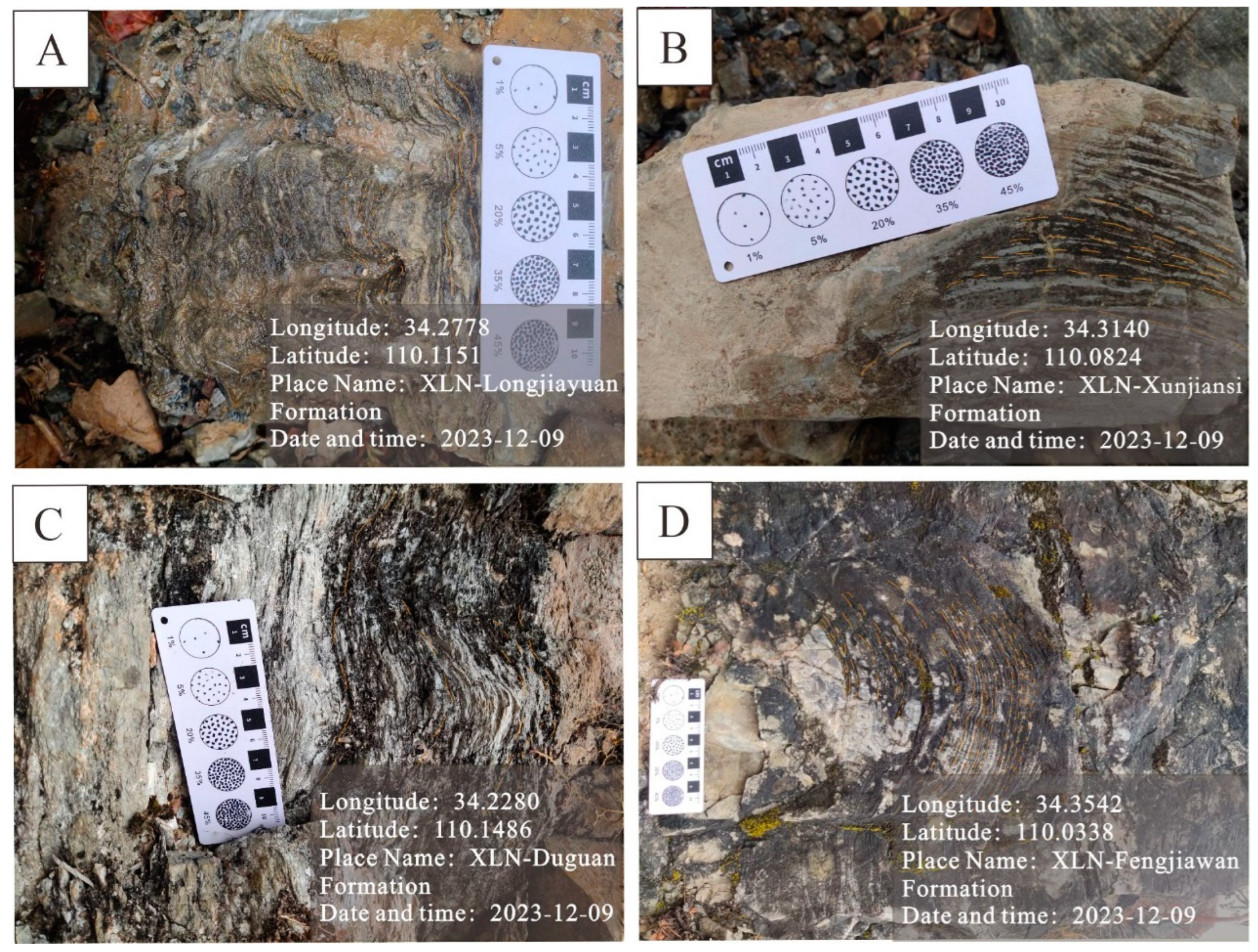
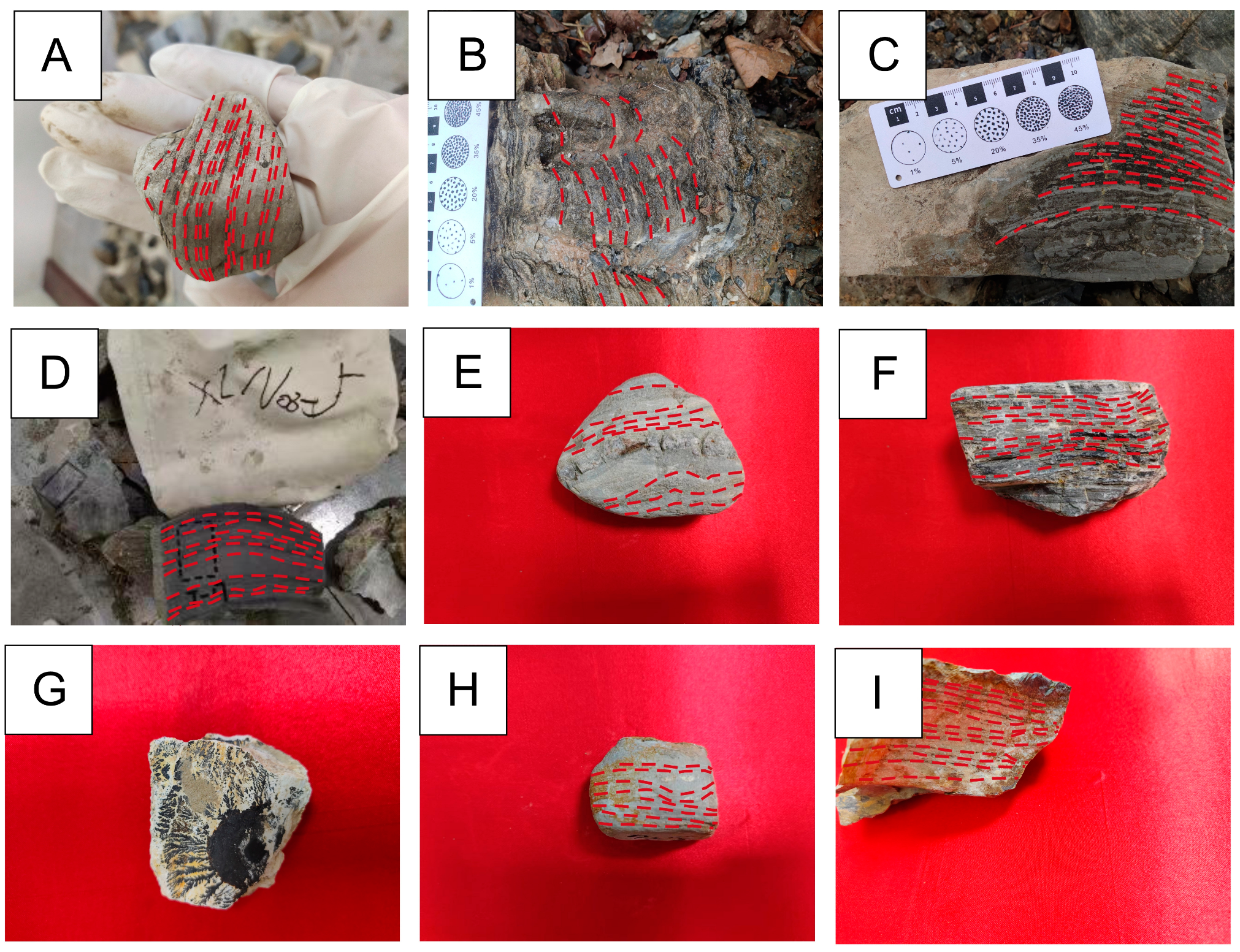
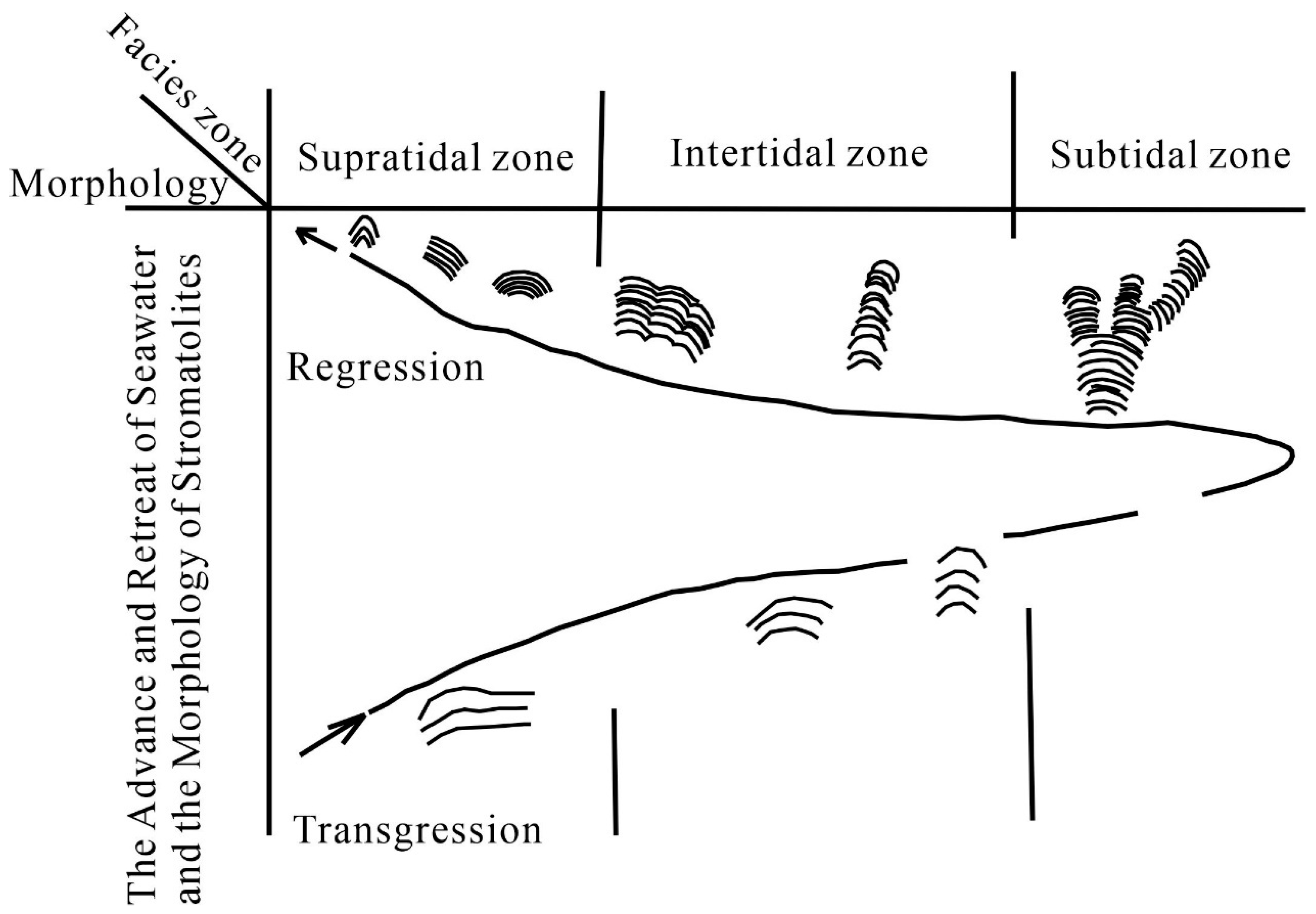

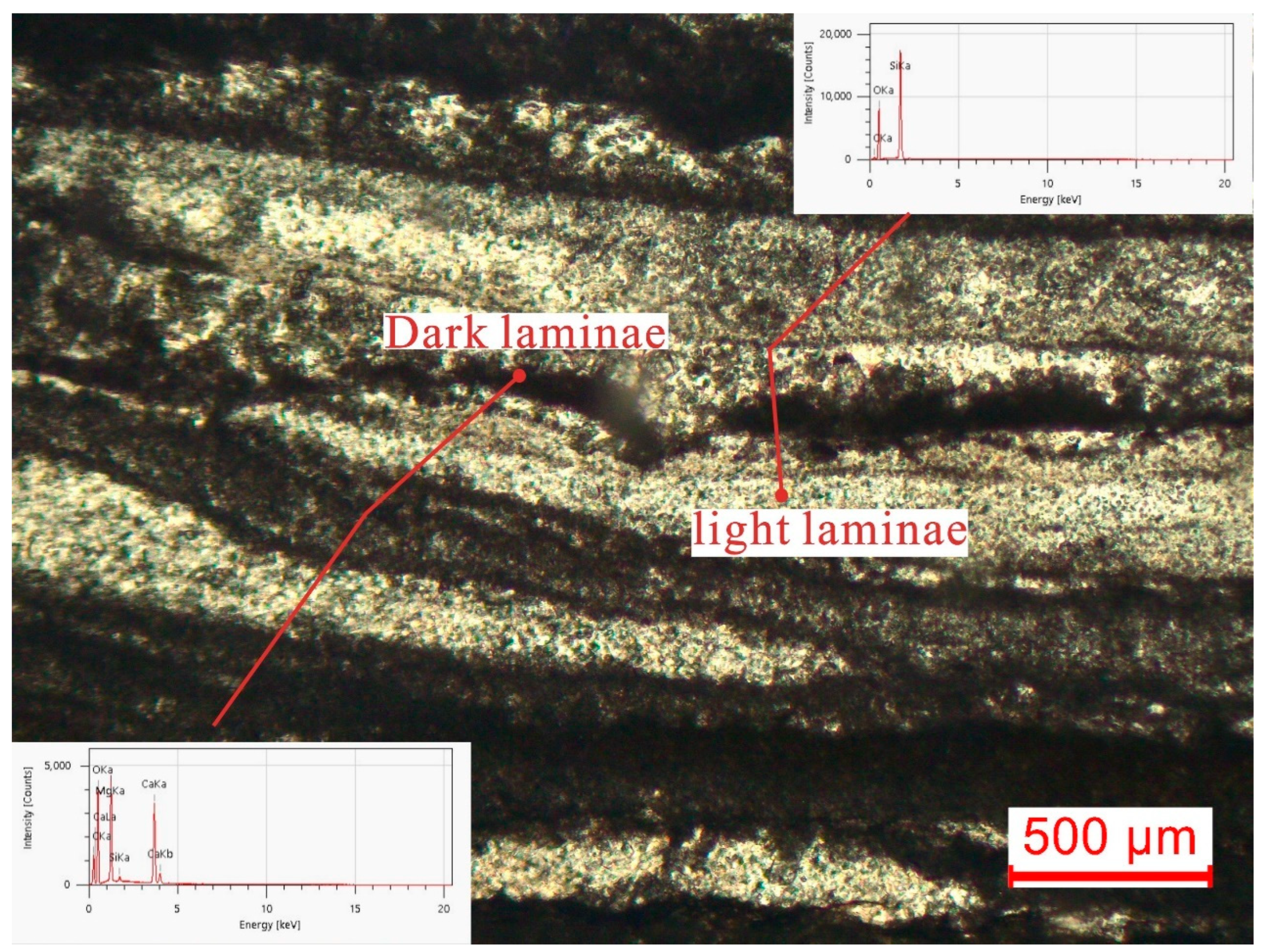
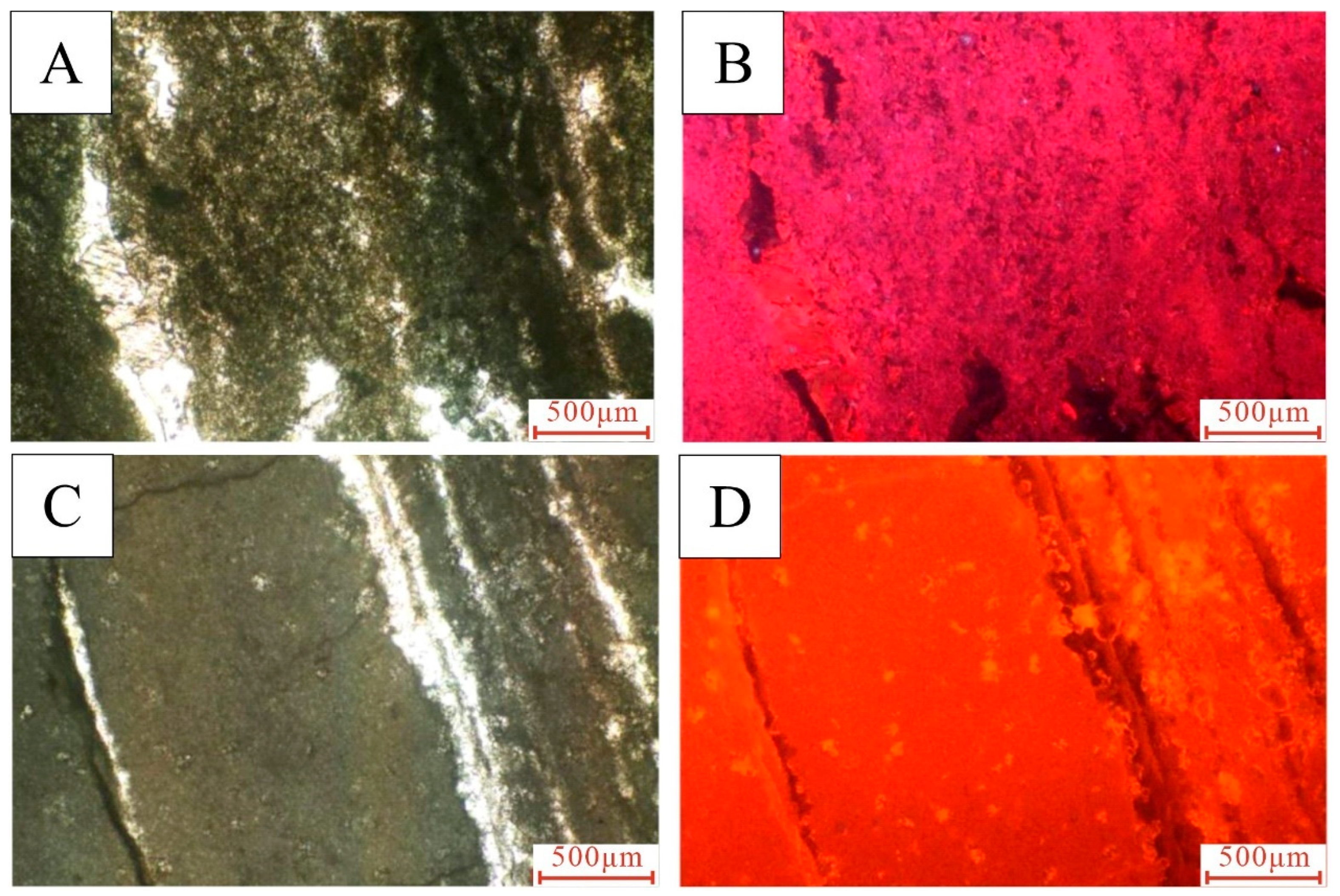
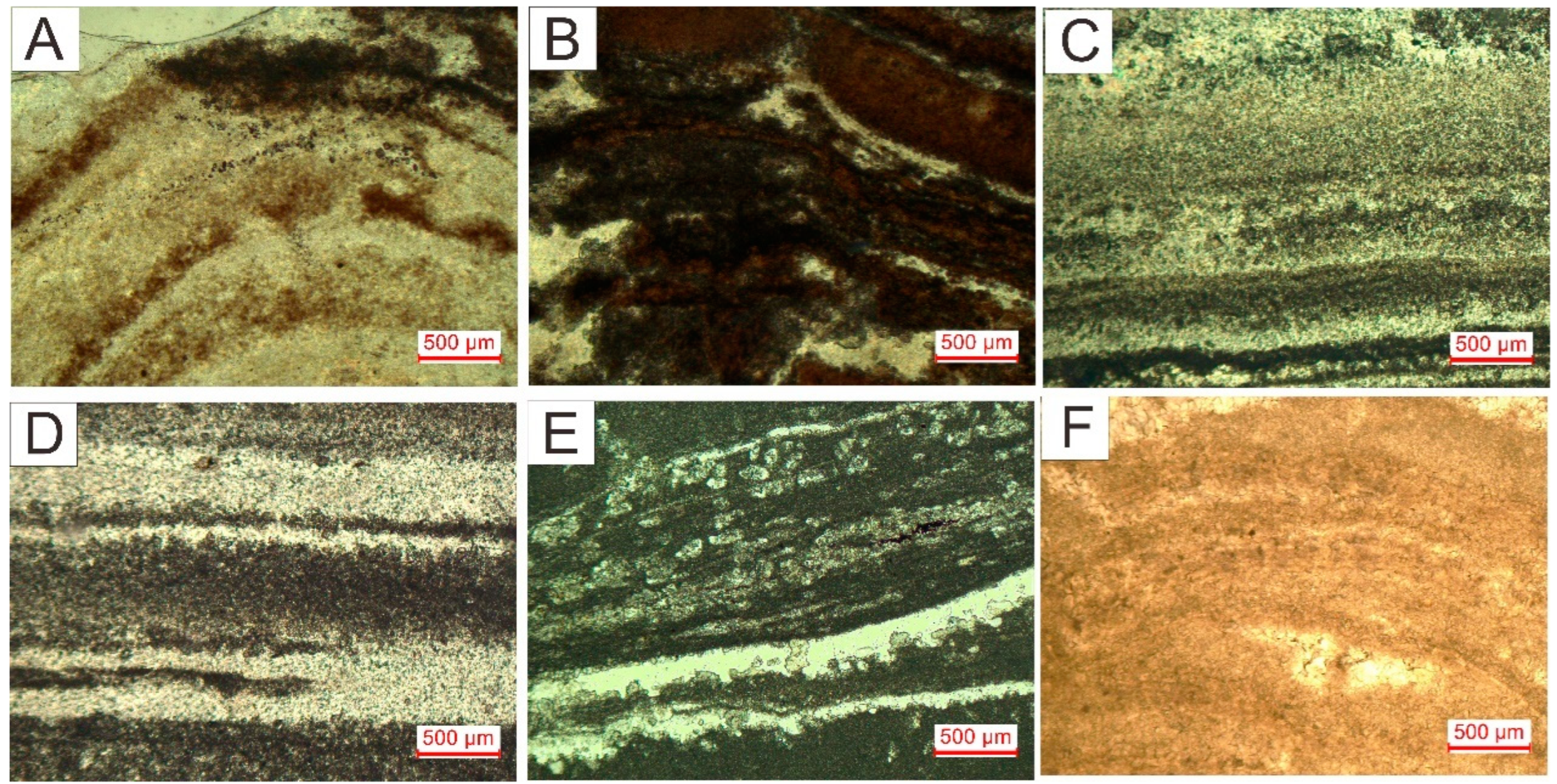


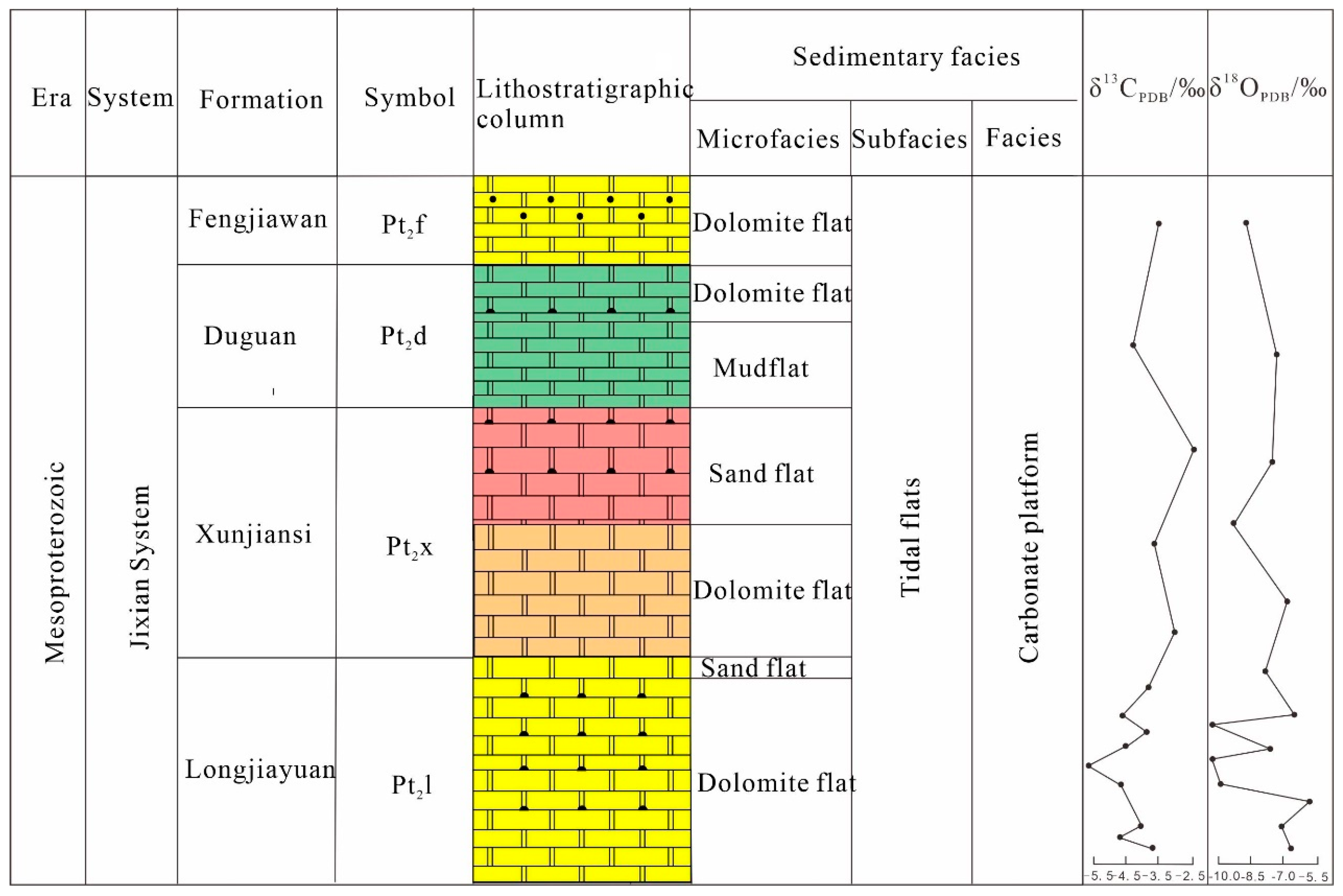
| Stromatolite Type | Description | Microstructure | Depositional Environment |
|---|---|---|---|
| Laminated stromatolites | Horizontal laminae, distinct light and dark layers. | Quartz, calcite, bioclasts. | Supratidal, low energy. |
| Wavy stromatolites | Undulating morphology | Micritic calcite, bioclasts, sand grains. | Middle intertidal, moderate energy. |
| Columnar stromatolites | with elliptical cross-sections and varied longitudinal profiles. | Bioclasts, sand grains. | Lower intertidal, subtidal, high energy. |
| Sample Number | Band Color | Na2O | SiO2 | MgO | K2O | CaO | P2O5 | SO3 | Al2O3 | MnO | FeO | F | TiO2 | CO2 | Total |
|---|---|---|---|---|---|---|---|---|---|---|---|---|---|---|---|
| T-22 | 1dark | 22.7 | 32.08 | 0.05 | 0.01 | 0.02 | 0.02 | 0.02 | 45.1 | 99.999 | |||||
| 2light | 21.68 | 0.02 | 31.64 | 0.01 | 0.06 | 0.01 | 0.05 | 46.52 | 99.999 | ||||||
| 3dark | 0.02 | 22.44 | 32.23 | 0.04 | 0.01 | 0.02 | 0.05 | 0.04 | 45.07 | 99.998 | |||||
| 4dark | 0.03 | 22.5 | 32.19 | 0.03 | 0.03 | 0.08 | 0.05 | 0.02 | 45.07 | 100 | |||||
| 5dark | 22.15 | 30.83 | 0.01 | 0.04 | 0.17 | 0.03 | 0.09 | 46.56 | 100 | ||||||
| 6light | 0.01 | 20.04 | 31.4 | 0.03 | 0.03 | 0.06 | 0.05 | 0.01 | 0.07 | 48.3 | 99.999 | ||||
| 7light | 0.01 | 23.46 | 32.8 | 0.01 | 0.01 | 43.72 | 100.001 | ||||||||
| 8light | 23.29 | 32.44 | 0.02 | 0.04 | 44.21 | 100 | |||||||||
| 9dark | 0.02 | 21.58 | 31.57 | 0.01 | 0.04 | 0.01 | 0.07 | 0.04 | 0.07 | 46.61 | 100.001 | ||||
| 10light | 22.13 | 31.3 | 0.01 | 0.03 | 0.03 | 46.34 | 99.999 | ||||||||
| T-23 | 1dark | 0.02 | 22.61 | 31.67 | 0.03 | 0.01 | 0.02 | 45.6 | 100.001 | ||||||
| 2light | 0.01 | 22.22 | 30.97 | 0.1 | 0.02 | 0.06 | 0.04 | 46.58 | 100.002 | ||||||
| 3light | 0.01 | 22.97 | 31.69 | 0.01 | 0.03 | 0.01 | 0.04 | 45.22 | 99.999 | ||||||
| 4dark | 0.31 | 22.74 | 0.03 | 32.23 | 0.02 | 0.02 | 44.64 | 100.001 | |||||||
| 5light | 4.39 | 23.11 | 30.35 | 0.04 | 42.02 | 100.001 | |||||||||
| 6light | 0.02 | 21.51 | 32.25 | 0.02 | 0.01 | 0.03 | 45.87 | 100.001 | |||||||
| 7dark | 0.04 | 22.56 | 0.01 | 32.28 | 0.03 | 0.02 | 0.08 | 45.02 | 100.001 | ||||||
| 8light | 21.92 | 30.55 | 0.05 | 0.01 | 0.04 | 0.03 | 0.15 | 0.09 | 47.05 | 100.001 | |||||
| 9dark | 0.021 | 21.99 | 29.98 | 0.05 | 0.01 | 0.13 | 47.82 | 100.001 | |||||||
| 10dark | 0.02 | 0.23 | 22.02 | 0.14 | 29.15 | 0.11 | 0.33 | 0.04 | 0.07 | 0.03 | 47.75 | 99.999 | |||
| T-24 | 1dark | 23.79 | 32.47 | 0.02 | 0.05 | 0.02 | 43.63 | 100 | |||||||
| 2light | 0.05 | 23.9 | 32.11 | 0.01 | 0.01 | 43.88 | 100.001 | ||||||||
| 3light | 22.53 | 30.32 | 0.01 | 0.03 | 0.02 | 0.09 | 0.01 | 0.02 | 46.97 | 99.999 | |||||
| 4dark | 0.01 | 22.8 | 0.01 | 30.96 | 0.04 | 0.02 | 0.03 | 46316 | 100 | ||||||
| 5dark | 23.53 | 29.91 | 0.01 | 0.04 | 0.13 | 46.38 | 100 | ||||||||
| 6light | 22.14 | 0.02 | 28.43 | 0.04 | 0.01 | 0.05 | 0.03 | 49.03 | 99.999 | ||||||
| 7light | 0.12 | 22.4 | 29.62 | 0.03 | 0.01 | 0.03 | 0.04 | 0.02 | 47.72 | 100.002 | |||||
| 8dark | 23.44 | 0.01 | 29.27 | 0.03 | 0.01 | 0.13 | 47.17 | 99.999 | |||||||
| 9light | 22.16 | 27.35 | 0.08 | 0.04 | 50.36 | 100.002 | |||||||||
| 10dark | 22.24 | 29.03 | 0.01 | 0.07 | 0.08 | 0.09 | 48.47 | 100 |
| Serial Number | Sample Number | Sample Stratigraphic Formation | δ13CPDB/‰ | δ18OPDB/‰ |
|---|---|---|---|---|
| 1 | XLN7-1 | Longjiayuan | −3.73 | −6.61 |
| 2 | XLN7-5 | Longjiayuan | −4.70 | −6.99 |
| 3 | XLN7-3 | Longjiayuan | −4.09 | −5.64 |
| 4 | XLN7-2 | Longjiayuan | −4.63 | −9.03 |
| 5 | XLN8-7 | Longjiayuan | −5.81 | −9.06 |
| 6 | XLN8-3 | Longjiayuan | −4.42 | −7.63 |
| 7 | XLN8-5 | Longjiayuan | −4.17 | −9.03 |
| 8 | XLN8-1 | Longjiayuan | −4.60 | −6.19 |
| 9 | XLN8-6 | Longjiayuan | −4.14 | −7.92 |
| 10 | XLN10-1 | Xunjiansi | −2.77 | −6.57 |
| 11 | XLN11-1 | Xunjiansi | −3.53 | −9.11 |
| 12 | XLN11-3 | Xunjiansi | −2.43 | −7.53 |
| 13 | XLN12-2 | Duguan | −4.40 | −7.44 |
| 14 | XLN13-1 | Fengjiawan | −3.05 | −7.63 |
| Sample Number | Mn (μg/g) | Sr (μg/g) | Mn/Sr (μg/g) | Sample Number | Mn (μg/g) | Sr (μg/g) | Mn/Sr (μg/g) |
|---|---|---|---|---|---|---|---|
| XLN7-5 | 53.354 | 39.114 | 1.364 | XLN13-1 | 83.396 | 88.679 | 0.940 |
| XLN7-1 | 51.287 | 255.446 | 0.201 | XLN8-5-2 | 60.958 | 64.984 | 0.938 |
| XLN8-6 | 27.461 | 14.878 | 1.846 | XLN8-7 | 48.957 | 56.871 | 0.861 |
| XLN3-1 | 22.086 | 16.252 | 1.359 | XLN8-1-1 | 75.466 | 345.338 | 0.219 |
| XLN5-1 | 163.607 | 168.590 | 0.970 | XLN8-3 | 47.619 | 30.095 | 1.582 |
| XLN7-2 | 36.422 | 17.770 | 2.050 | XLN12-3 | 66.262 | 79.813 | 0.830 |
| XLN12-2 | 56.038 | 29.434 | 1.904 | XLN5-2 | 330.779 | 198.701 | 1.665 |
| XLN8-5-1 | 41.610 | 25.635 | 1.623 | XLN7-5-1 | 58.675 | 37.098 | 1.582 |
| XLN7-3 | 42.885 | 32.308 | 1.327 | XLN8-1-2 | 176.252 | 96.213 | 1.832 |
| Serial Number | Sample Number | Sample Stratigraphic Formation | δ13Ccarb |
|---|---|---|---|
| 1 | XLN5-1 | Xunjiansi | −2.401 |
| 2 | XLN6-1 | Fengjiawan | −0.861 |
| 3 | XLN7-1 | Longjiayuan | −0.299 |
| 4 | XLN7-2 | Longjiayuan | −0.548 |
| 5 | XLN7-3 | Longjiayuan | −0.527 |
| 6 | XLN7-5 | Longjiayuan | −0.709 |
| 7 | XLN8-1 | Longjiayuan | −0.699 |
| 8 | XLN8-3 | Longjiayuan | −3.857 |
| 9 | XLN8-6 | Longjiayuan | −0.409 |
| 10 | XLN8-5 | Longjiayuan | −0.634 |
| 11 | XLN8-7 | Longjiayuan | −1.585 |
| 12 | XLN9-1 | Duguan | −11.849 |
| 13 | XLN10-1 | Xunjiansi | 1.097 |
| 14 | XLN11-1 | Xunjiansi | 1.066 |
| 15 | XLN11-3 | Xunjiansi | 1.034 |
| 16 | XLN12-2 | Duguan | 0.286 |
| 17 | XLN12-3 | Duguan | −0.431 |
| 18 | XLN13-1 | Fengjiawan | 0.517 |
| Serial Number | Sample Stratigraphic Formation | Lithology | C/% | S/% |
|---|---|---|---|---|
| 1 | Longjiayuan | carbonate rock | 0.296 | 0.0266 |
| 2 | Xunjiansi | carbonate rock | 0.324 | 0.0255 |
| 3 | Longjiayuan | carbonate rock | 0.125 | 0.0241 |
| 4 | Longjiayuan | carbonate rock | 1.17 | 0.0190 |
| 5 | Xunjiansi | carbonate rock | 0.138 | 0.0261 |
| 6 | Longjiayuan | carbonate rock | 0.681 | 0.0246 |
| 7 | Fengjiawan | carbonate rock | 0.817 | 0.0273 |
| 8 | Longjiayuan | carbonate rock | 0.369 | 0.0207 |
| 9 | Duguan | carbonate rock | 0.142 | 0.0278 |
| 10 | Longjiayuan | carbonate rock | 0.871 | 0.0220 |
| 11 | Erdaohe | carbonate rock | 0.139 | 0.0249 |
| 12 | Biegaizi | quartz sandstone | 0.132 | 0.0263 |
| 13 | Chenjiajian | carbonate rock | 0.139 | 0.0259 |
| 14 | Longjiayuan | carbonate rock | 0.258 | 0.0247 |
| 15 | Longjiayuan | carbonate rock | 0.123 | 0.0243 |
| 16 | Duguan | carbonate rock | 0.143 | 0.0274 |
| 17 | Xunjiansi | sandstone | 0.222 | 0.0287 |
| 18 | Longjiayuan | carbonate rock | 0.160 | 0.0255 |
| 19 | Chenjiajian | quartz sandstone | 0.128 | 0.0261 |
| 20 | Xunjiansi | carbonate rock | 0.478 | 0.0243 |
| Serial Number | Sample Number | Stratigraphic Formation | Diagenetic Temperature | T |
|---|---|---|---|---|
| 1 | XLN7-1 | Longjiayuan | 45.65 | 16.10 |
| 2 | XLN7-5 | Longjiayuan | 47.53 | 20.18 |
| 3 | XLN7-3 | Longjiayuan | 40.72 | 14.48 |
| 4 | XLN8-3 | Longjiayuan | 50.82 | 23.07 |
| 5 | XLN8-1 | Longjiayuan | 43.49 | 16.76 |
| 6 | XLN8-6 | Longjiayuan | 52.31 | 10.16 |
| 7 | XLN10-1 | Xunjiansi | 45.42 | 18.38 |
| 8 | XLN11-1 | Xunjiansi | 58.52 | 30.09 |
| 9 | XLN11-3 | Xunjiansi | 50.29 | 17.72 |
| 10 | XLN12-2 | Duguan | 49.84 | 22.19 |
| 11 | XLN13-1 | Fengjiawan | 50.81 | 23.05 |
| Number | Sr (μg/g) | Cu (μg/g) | Sr/Cu |
|---|---|---|---|
| XLN7-5 | 39.114 | 39.873 | 0.98 |
| XLN7-1 | 255.446 | 44.356 | 5.76 |
| XLN8-6 | 14.878 | 40.251 | 0.37 |
| XLN3-1 | 16.252 | 36.552 | 0.44 |
| XLN5-1 | 168.590 | 42.885 | 3.93 |
| XLN7-2 | 17.770 | 38.722 | 0.46 |
| XLN12-2 | 29.434 | 34.679 | 0.85 |
| XLN8-5-1 | 25.635 | 40.495 | 0.63 |
| XLN9-1 | 3.581 | 25.638 | 0.14 |
| XLN7-3 | 32.308 | 41.154 | 0.78 |
| XLN13-1 | 88.679 | 41.132 | 2.16 |
| XLN8-5-2 | 64.984 | 41.022 | 1.58 |
| XLN8-7 | 56.871 | 40.491 | 1.40 |
| XLN6-2 | 9.085 | 15.937 | 0.57 |
| XLN8-1 | 345.338 | 42.058 | 8.21 |
| XLN8-3 | 30.095 | 41.143 | 0.73 |
| XLN12-3 | 79.813 | 39.252 | 2.03 |
| XLN5-2 | 198.701 | 37.091 | 5.38 |
| XLN7-5-1 | 37.098 | 41.262 | 0.90 |
Disclaimer/Publisher’s Note: The statements, opinions and data contained in all publications are solely those of the individual author(s) and contributor(s) and not of MDPI and/or the editor(s). MDPI and/or the editor(s) disclaim responsibility for any injury to people or property resulting from any ideas, methods, instructions or products referred to in the content. |
© 2025 by the authors. Licensee MDPI, Basel, Switzerland. This article is an open access article distributed under the terms and conditions of the Creative Commons Attribution (CC BY) license (https://creativecommons.org/licenses/by/4.0/).
Share and Cite
Yuan, R.; Yu, Q.; Tian, T.; Yang, Q.; Ren, Z.; Li, R.; Wang, B.; Chang, W.; He, L.; Wang, T. Characteristics and Paleoenvironment of Stromatolites in the Southern North China Craton and Their Implications for Mesoproterozoic Gas Exploration. Processes 2025, 13, 129. https://doi.org/10.3390/pr13010129
Yuan R, Yu Q, Tian T, Yang Q, Ren Z, Li R, Wang B, Chang W, He L, Wang T. Characteristics and Paleoenvironment of Stromatolites in the Southern North China Craton and Their Implications for Mesoproterozoic Gas Exploration. Processes. 2025; 13(1):129. https://doi.org/10.3390/pr13010129
Chicago/Turabian StyleYuan, Ruize, Qiang Yu, Tao Tian, Qike Yang, Zhanli Ren, Rongxi Li, Baojiang Wang, Wei Chang, Lijuan He, and Tianzi Wang. 2025. "Characteristics and Paleoenvironment of Stromatolites in the Southern North China Craton and Their Implications for Mesoproterozoic Gas Exploration" Processes 13, no. 1: 129. https://doi.org/10.3390/pr13010129
APA StyleYuan, R., Yu, Q., Tian, T., Yang, Q., Ren, Z., Li, R., Wang, B., Chang, W., He, L., & Wang, T. (2025). Characteristics and Paleoenvironment of Stromatolites in the Southern North China Craton and Their Implications for Mesoproterozoic Gas Exploration. Processes, 13(1), 129. https://doi.org/10.3390/pr13010129










